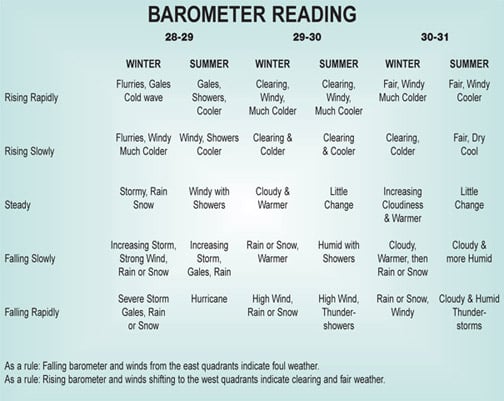Preparing Your Trip
4.8 Weather
At the very least, poor weather can spoil a trip: at the very worst, it can cause an emergency situation on the water.
Weather is an important subject for pleasure craft operators because they are the most vulnerable to sudden storms and squalls, as well as searing heat.
Always check the weather before you decide to leave the dock. It is much better to postpone a trip than to become a casualty of the weather.
While underway, continue listening to updated forecasts.
There are specific weather courses available for pleasure craft operators and even the simplest can aid you in understanding weather and weather patterns. That knowledge could help warn you in advance about difficult weather.
How to use a Barometer
In order to use a Barometer correctly, readings must be taken regularly, usually every six hours, and recorded, or remembered.
Some Barometers have a mechanical pointer that can be changed to the new reading, then left until it is time to take a new reading.
Coming weather is indicated by the overall change in the Barometric Pressure, which is what the Barometer measures.
Find the current reading and compare it to the previous reading to discover overall change and determine if the change is occurring slowly or rapidly.
Compare the change to the currentreading and the season to learn the approaching weather.

Sources
There are many sources of weather information available to the pleasure craft operator: radio, newspapers, the weather channel, VHF weather reports, barometer readings, the thermometer, Environment Canada, and an observation of current conditions can help you determine whether or not you should be out in your boat.
You should learn how to use a barometer. It can provide local advance warning of storms and squalls.
An easy to use Barometer Chart is included in this section along with some helpful weather tips. Both these items are not examinable.
Weather Tips
These tips are provided to help you observe the weather. These are generalizations good for large bodies of water and temperate climates. Local conditions, such as the location of land, may cause some variations, especially in local wind direction, to the observations and predictions.
- Avoid a storm's centre by tracking its movement in relation to your course. Put your back to the wind and point to the left, that's where the storm centre lies.
- If you see storm clouds anywhere to the west or north of your position in a temperate climate, you are in the danger zone and may be in its path.
- Thunder is nearby if it crashes and bangs, far off if it rumbles like a timpani. Thunder travels at about one mile for every five seconds or, one kilometre for every three seconds.
- If the wind changes in a clockwise direction, fair weather is on the way. If the wind changes in a counterclockwise direction, fair weather is leaving.
- Doubling of wind speed quadruples its strength. Strength causes waves.
- High clouds are associated with weather about six hours away. Wispy and white indicate fair weather.
- Low clouds are from close-by weather systems. Dense and dark indicate ominous change.
- Standing with your back to the wind, look up. If high altitude clouds move from left to right, the weather will worsen; right to left, it will improve. If clouds move toward or away from you, expect little change.
Wind Speed
Marine warnings are broadcast when winds reach certain speeds. It is important to know the wind speed warnings and to understand what they mean for you as a pleasure boat operator.
One Knot = One nautical mile per hour
Light Winds - Wind speeds of 1 - 14 knots (1-16 mph or 1-26 km/h)
Moderate Winds - Wind speeds of 15 - 19 knots (17-22 mph or 28-35 km/h)
Strong Winds - Wind speeds of 20 - 33 knots (24-37 mph or 39-54 km/h)
Gale - Wind speeds of 34 - 47 knots (39-54 mph or 63-87 km/h)
Storm - Wind speeds of 48 - 63 knots (55-73 mph or 89-117 km/h)
Weather Warnings
Pleasure boat operators must learn to recognize what the following weather warnings signify.
Small Craft Warning - This is issued if winds are expected to sustain in the range of 20 to 33 knots.
Gale Warning - This is issued if winds are expected to sustain in the range of 34 to 47 knots.
Storm Warning - This is issued if winds are expected to sustain in the range of 48 to 63 knots.
Next Page: 4.9 Water-Related Activities